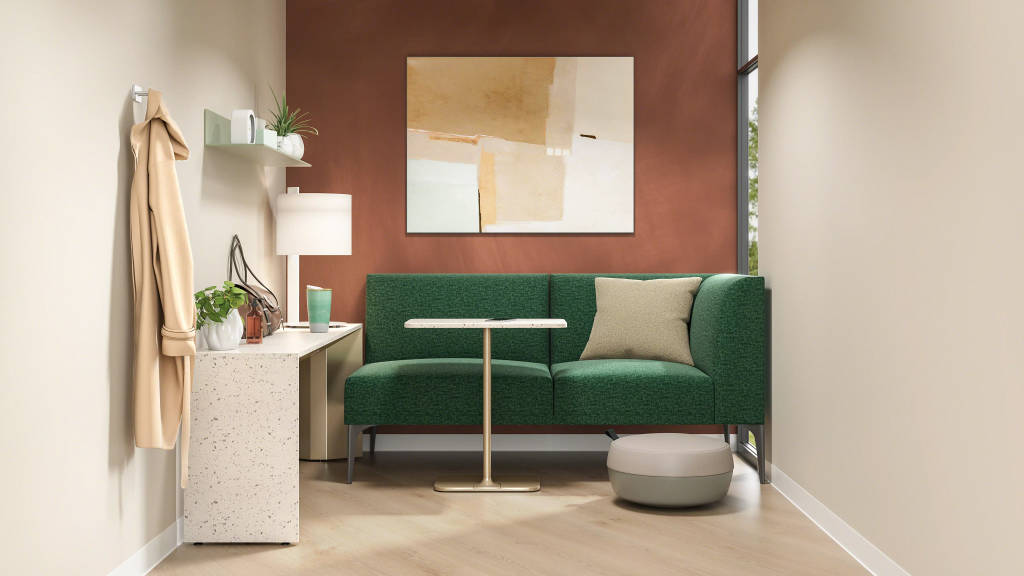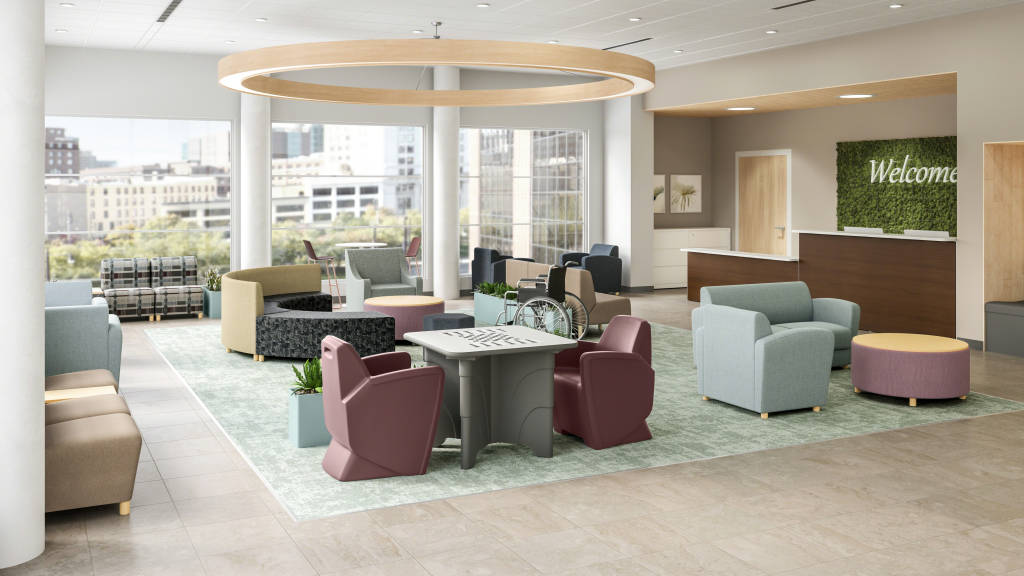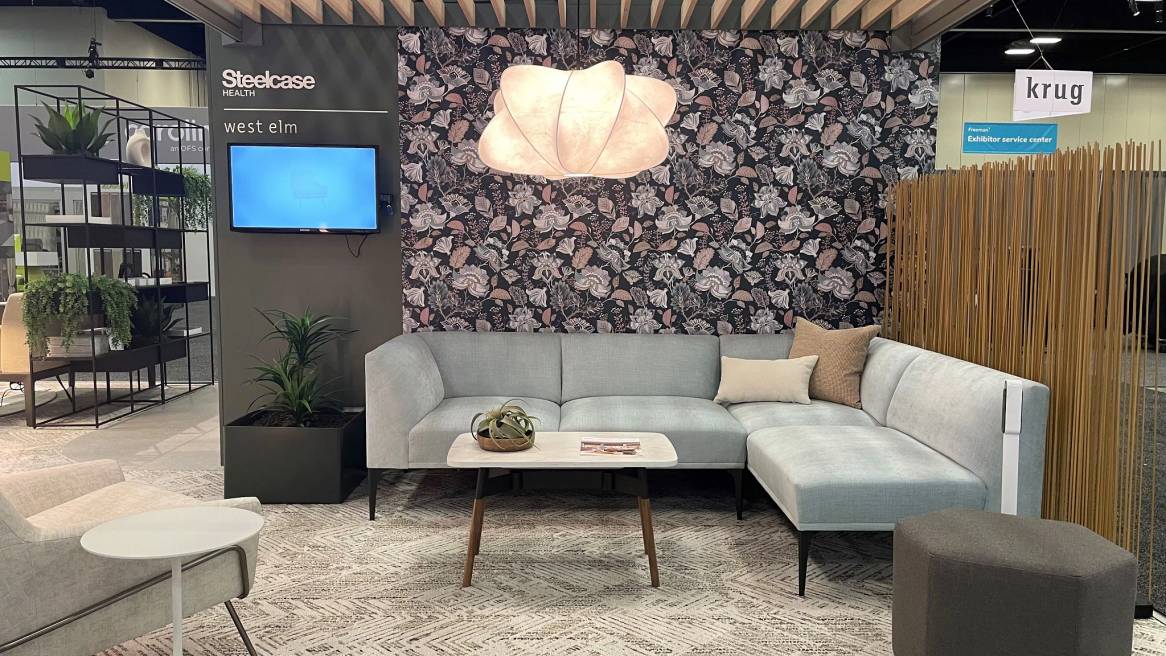Healthcare Design Moving Forward
Key takeaways from the 2022 Healthcare Design Conference & Expo
Steelcase Health design and research experts recently attended the 2022 Healthcare Design Conference & Expo, the premier networking and educational event in the industry.
We asked Applications Designers Beth Bronson and Katie VanWagner along with Seth Starner, head of our Advanced Explorations team, to share top themes and key takeaways from this important event.
Work Better: What high-level impressions and insights did you gain about the future of healthcare design?
Seth Starner: While the topics we heard weren’t necessarily brand new, there was a heightened emphasis on inclusive access to care, better care for caregivers, behavioral healthcare challenges, the need for more evidence-based design and designing for flexibility and modularity.
What was different this year was the stress placed on addressing these themes sooner versus later. Covid was an extreme pressure test on the whole system. Clinicians performed above and beyond, but the crisis really identified where the holes and weaknesses in healthcare are. What’s emerging now is a stronger-than-ever realization that purposeful, human-centered design can have a very positive effect.
Beth Bronson: And, related to that, there’s more realization of how healthcare spaces can be designed to improve healthcare outcomes for everyone involved — patients and their families, as well as clinicians and staff.
Work Better: How can spaces improve healthcare today?
Beth Bronson: Here’s one example. I attended a session about clinician burnout — why does it happen? One big reason: Clinicians are always coping with sickness and death. It’s an unavoidable reality of the job, and space can’t change that. But there are other causes of burnout, too: busy, high-stress environments and always putting others first. Space can be a tool to address those things.

Spaces for breaks have typically been minimized in the floorplate and their location can be inconvenient for actual use. If you only have 15 minutes for a break and it takes you five minutes to get to the breakroom, are you really going to use it? Providing spaces is one thing, but their location is another important factor to consider.
And then there’s the experience. Many breakrooms have become cluttered spaces or overflow storage rooms — in other words, an afterthought. Or they’re just one big, noisy room. A nurse in one session said, “I’m not going to feel comfortable going into the breakroom to cry during a difficult shift while sitting next to a coworker who is eating lunch.” Respite means different things to different people, so there need to be diverse types of respite areas available to suit various needs. And they don’t all have to be big rooms. Organizations are looking for ways to reclaim underutilized spaces and repurpose them for respite spaces instead.
Katie VanWagner: And it’s so important that spaces for taking a break are well maintained, warm and welcoming. Furnishings, surface materials, color choices and natural light play a big part in that.
Seth Starner: There are signs that the whole culture of clinician self-sacrifice is starting to be challenged and recognized as unsustainable, that clinicians can’t give the best care if their own needs are being ignored. It’s becoming a big recruitment and retention issue.
Beth Bronson: Some systems are even giving their respite spaces different names — like resiliency rooms — to help break the stigma.
Seth Starner: Clinician wellbeing also relates to supporting socialization and teamwork. The number one thing that keeps a team and an inpatient floor going is teamwork. A good, highly functioning team supports every individual. When teamwork falls apart, people start to feel really isolated. And that’s a culture issue but also a facilities issue — how can space nudge better collaboration and teamwork, how can that social ecosystem get built in the space? We know relationships are created in off moments, in socialization. Once that’s in place, then clinicians know they can trust each other when the pressure is on.
Work Better: What are some other top priorities in healthcare design?
Seth Starner: Behavioral health. Specifically, the speed at which the industry is being forced to adjust to the surge that’s happening. It’s become a huge thing, affecting people of all ages and straining the system from pediatrics to senior care. There’s more emphasis on design guidelines and products like those we offer through our ModuForm partnership that are specially designed to support the comfort and safety of behavioral health patients and clinicians.

Katie VanWagner: Also, the emphasis on natural light and transparency for wellbeing and sustainable buildings is still growing. The evidence has been around for many years, but much of it has been focused on patient rooms. Now there’s a realization that natural light is good for everyone in every kind of space, even putting small windows in operating rooms so surgeons can have a quick moment of eye relief.
Incorporating openness and light wherever possible is a recurring theme, as well as how furnishings and applications can help support that. It is also important to pay attention to light reflectance values and how surface materiality can influence light levels within an environment.
Work Better: What else is driving interest in flexibility and modularity?
Beth Bronson: People have been quickly learning how important it can be to have a space set up one way and then be able to quickly change it for a completely different use. If you have fixed components like built-in millwork, you have very limited opportunity to change those components out quickly.
Especially with the pressure coming from increasing construction costs, supply chain issues and inflation fears, the need to design for both current and future needs is top of mind for every decision maker. Modularity wherever possible makes a lot of sense.
Work Better: Closing thoughts?
Beth Bronson: Designers and architects are relying on technology advancements to create templated designs. What this means is taking the time upfront to program and design a solution that’s perfect for their client in a specific type of setting — a patient room, for example — and then duplicating that design throughout that facility. Designers are leaning on technology to help them save time and be more efficient, which reduces costs.
Seth Starner: Technology is also playing a big role in improving access to healthcare for people who face obstacles for in-person appointments, such as the hardship of taking time away from work or childcare, or the extra burden of transportation costs on a tight budget. Virtual care has grown rapidly, and practitioners are still struggling with the challenges of doing it right. One solution that addresses this reality is the ATLAS virtual care stations for veterans in rural areas that Steelcase developed in partnership with Philips, the global healthcare technology leader. ATLAS has been recognized for its exemplary use of evidence-based design processes. As a pilot project, it has taught us a lot about the impact of space on effective virtual care.
Steelcase Health continuously tracks and researches the healthcare industry to design evidence-based, safe and sustainable solutions for people who receive care and those who provide it. We believe that transformative experiences of care begin with more caring spaces, and we know that spaces can have a profound impact on health outcomes, influencing the wellbeing of everyone involved.
Learn more by connecting with an expert for our latest research and products to support healthcare spaces.


